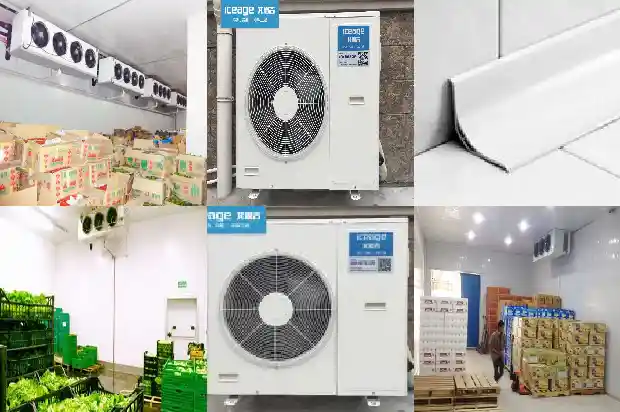Marine Refrigeration Unit
2025-04-09
Freezing and refrigeration facilities are used in the cargo holds of marine fishing vessels, commercial refrigerated ships, and maritime transport ships, as well as in the daily lives of the crew members. There are also some special ships, such as engineering vessels and liquefied gas carriers, that require refrigeration facilities.
In the fishing industry, the caught fish need to be cooled, frozen, processed, and stored. Commercial refrigerated ships are required to transport various aquatic products and refrigerated foods; for the daily life of the crew members on the ship, cold storage for storing food and refrigeration devices capable of providing cold drinks and cold food are needed.
The refrigeration devices used in refrigerated ships include ammonia refrigeration and Freon refrigeration devices. In the early days, ammonia refrigeration was more commonly used in refrigerated ships and fishing vessels. However, nowadays, most general refrigerated ships or refrigerated cargo holds use Freon refrigeration devices. The refrigeration compressors are mostly piston-type, and screw compressors are also used on large ships. Cascade refrigeration is often adopted for quick freezing. The cooling methods include coil cooling or air-blowing cooling.


The operating conditions and auxiliary equipment of marine refrigeration devices need to be selected and matched according to the types of goods being transported, the cooling requirements, the thermal insulation requirements, etc. The design and assembly process of marine refrigeration devices should comply with relevant national and international standards, and it is required to be equipped with refrigerant leakage detection alarms and a safety system. Generally, the refrigeration system is required to include the following functions: overload alarm and automatic shutdown of the compressor motor; overpressure and overtemperature alarm for the compressor exhaust, low-pressure and overtemperature alarm for the lubricating oil and automatic shutdown; low-temperature alarm for the cargo hold; overload alarm for the fan; Freon leakage alarm; abnormal alarm and automatic shutdown of the cooling water circulation, etc. In case of a failure, the control panel of the refrigeration device or the unit control room should issue audible and visual alarms and be able to automatically print records.
The pipelines such as oil pipelines, gas pipelines, and water pipelines in marine refrigeration devices should be made of materials that are resistant to seawater corrosion and approved by the classification society. When insulating materials are wrapped around the outside of low-temperature pipelines, anti-low-temperature glue should be applied between the materials and the pipe wall, and waterproof materials should also be wrapped outside the insulating materials. The pressure vessels in the refrigeration device should be equipped with safety diaphragms and safety valves installed in series (for containers with a capacity of less than 100L in the Freon system, fusible plugs with a melting point of 65°C can be used). The paint used for the appearance of the refrigeration device should also take corrosion prevention into account, and special marine paint should be used.

Against the backdrop of the development of the marine economy, the government has successively introduced some policies to support the marine economy. In 2015, the Ministry of Agriculture had already required that steel fishing vessels 40 meters or longer (including 40 meters) and fiberglass fishing vessels 24 meters or longer (including 24 meters) must be equipped with refrigeration systems (including compressors, condensers, evaporator coils, and liquid receivers, etc.) and provided with certain subsidies.

Related Articles
- Do You Know These Basic Refrigeration Knowledge?
- Top Ten Common Faults of the Refrigeration System: Analysis and Solutions Included!
- Commissioning of the Refrigeration System after Installation and Major Overhaul: Very Detailed!
- Selection Methods for Site, Capacity, Insulation Materials and Refrigeration System in Cold Storage Construction Design
- Classification, Applications, Identification of Common Refrigerants and Impact of Purity on Refrigeration Systems
- The Basic Refrigeration Working Principle of Cold Storage
- What Causes the Evaporation Temperature in a Cold Storage Refrigeration System to Be Too Low?
- Basic Knowledge of Valve - type Components in Refrigeration Systems (Technical Sharing)
- Eye - opening! Dynamic Demonstration of the Principles and Applications of Refrigeration Systems
- Did You Know? Any Incompatibility between Base Oil and Refrigerant Could Destroy a Refrigeration Compressor
- Simple and Understandable Installation Method of Vibration - isolation Tubes for Refrigeration Compressors
- Introduction: Ten Key Points Every Refrigeration Professional Should Know
- Introduction to Cold Storage Refrigeration Systems
- Do You Know All These Knowledges about the Absorption Unit of the Lithium Bromide Refrigeration Machine?
- Collection! Comprehensive Guide to Energy Saving of Refrigeration Systems - Cold Storage System Edition
- Understand These 50 Refrigeration and HVAC Terms to Make You More Professional
- How to Perform Pressure Testing, Leak Detection and Blockage Inspection on Refrigeration Equipment?
- A Summary of 11 Common Faults in Refrigeration and Air Conditioning Systems
